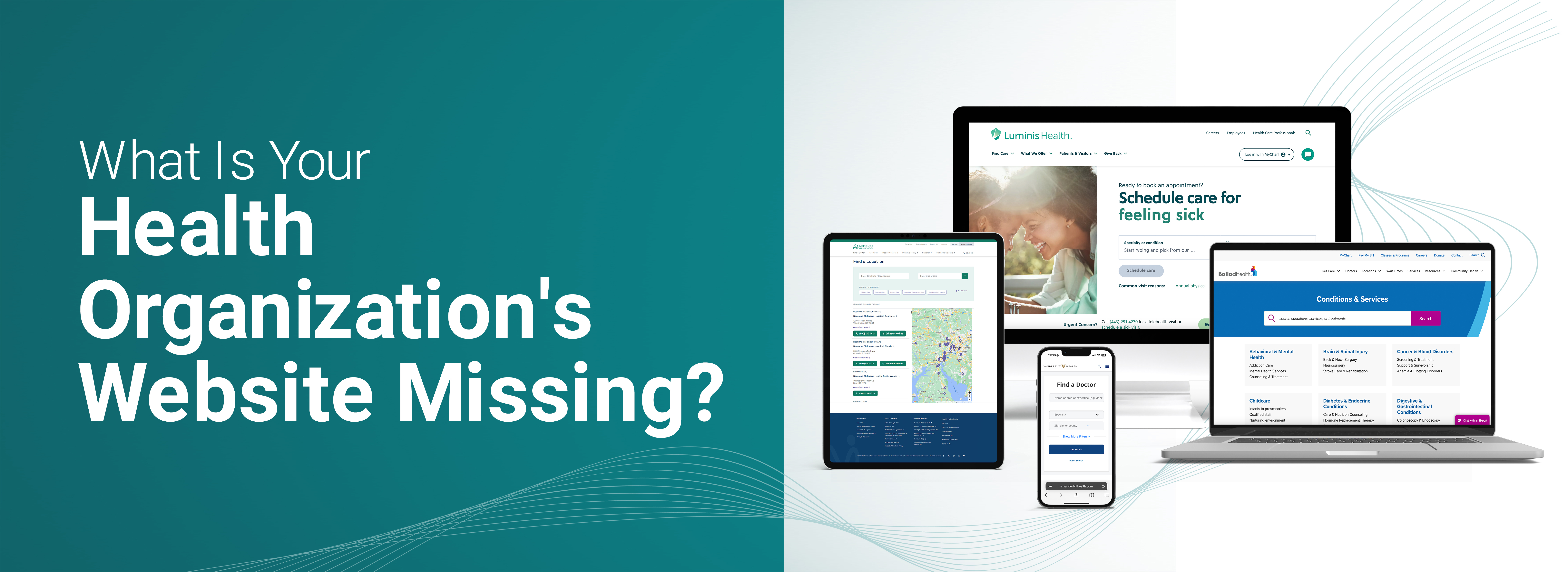
Your organization’s website serves as a primary digital asset for current and potential patients to access vital information, essential services, and meaningful support throughout their care journey. In patients’ or caregivers’ times of need, the website can play a central role and be a differentiator when it comes to choosing a provider. The website is often the gateway to patients being able to access the care they need. Therefore, ensuring that your website delivers a positive patient experience is crucial for meeting the needs of patients and maintaining market share.
This blog will delve into consumer expectations and best practices for healthcare websites, focusing on attracting and engaging users and enhancing the online patient experience. We will draw from out-of-industry best practices as well as highlight important design considerations for healthcare audiences.
Consumer Expectations
Currently, consumers are spending more on their healthcare compared to the past two years. The US’s National Health Expenditures (NHE) grew by 4.1% to $4.5 trillion in 2022, amounting to $13,493 per person. This accounted for 17.3% of Gross Domestic Product (GDP). Mainly, hospital care and physician services drove this spending increase, with average annual growth rates of 4.4% and 4.2%, respectively. As healthcare costs continue to rise, it underscores the need for innovative approaches to delivering high-quality care while maintaining affordability for consumers.
Despite spending more money per capita on healthcare than any other wealthy country, a considerable percentage remains dissatisfied with their overall healthcare experiences. A recent Harris Poll survey commissioned by the American Academy of Physician Associates shows declining patient satisfaction. This decline is attributed to high costs, lack of accessibility, and confusing logistics of the healthcare system. Given the persistent dissatisfaction among patients with their healthcare experiences, investing in digital assets offers a strategic opportunity for healthcare organizations. It enables them to address the root causes, such as high costs and accessibility issues highlighted in the survey. By leveraging digital technologies, healthcare providers can streamline processes, improve communication, and offer personalized care, ultimately enhancing patient satisfaction and loyalty.
While industries like banking, media, and e-commerce have made notable advancements in digital consumer engagement, healthcare still falls behind. Bridging this gap is pertinent to meet the shifting expectations of today’s consumers in the interconnected digital landscape, where they anticipate seamless experiences regardless of industry. This expectation necessitates a concerted effort towards digital transformation within the healthcare industry so that patients receive the same level of convenience, accessibility, and personalized service that they have come to expect from other sectors.
What do banking, media, and e-commerce have in common?
The pace and frequency of consuming digital have continued to increase over the years, and are not slowing down. The industries that are staying ahead of consumer preferences through digital consumption are banking, media, and e-commerce. But, how have they stayed ahead?
By adopting a product-oriented mindset and operating in a manner more aligned with a technology company, while also harnessing the power of customer data.
In embracing a product mindset and utilizing consumer data, banking, media, and e-commerce industries have adjusted to evolving market dynamics and consumer demands. Banking, in particular, is drawing inspiration from e-commerce, emphasizing digital-first experiences and advanced toolsets to elevate the standard for digital interactions.
This commitment to digital transformation has seamlessly integrated innovative technologies and processes, enhancing efficiency and prioritizing customer-centricity. With a focus on customer journeys, banking has refined its approach, distinguishing itself with a performance-as-experience ethos. Additionally, leveraging customer data has empowered these industries to finely tune products, services, and experiences, shaping consumer interactions with precision. As trailblazers in transformative practices, banking, media, and e-commerce continue to set the benchmark for customer-centric innovation in the digital age. To effectively meet consumer expectations, organizations must perpetually innovate and evolve their digital strategies to bolster agility.
These industries are great examples of prioritizing the consumer in their efforts to enhance the customer experience, while also navigating the challenges inherent in adopting new technologies to simplify and streamline user interactions. Although the healthcare sector may face unique hurdles in integrating digital capabilities compared to banking, media, and ecommerce, acknowledging and learning from the advancements in these sectors can serve as valuable guidance.
What should be included in a healthcare website?
Easy-to-navigate design
Regularly analyzing your website’s performance is important to distinguish what works effectively and what doesn’t. Ensuring that your website design is simple and engaging should be your primary focus. Overcomplicating the online user experience for current or potential patients could drive them away from scheduling appointments on your site and even towards your competitors.
Understanding which elements perform well on your website is similar to deciphering your audience’s preferences and behaviors. It’s not just about recognizing what works; it’s about understanding why it works. By pinpointing successful elements, you gain valuable insights into how to strengthen them, ultimately enhancing user engagement.
Finding out what doesn’t work well is equally important. Research shows that a poor digital experience can lead to negative provider reviews from one in five patients. Examining critical user pathways, such as appointment scheduling, to assess how effectively your website’s design facilitates this process is an excellent approach to analyzing its performance. Ideally, this process should be streamlined, taking no more than five clicks. This ensures a user-friendly experience and encourages higher engagement rates.
To fully understand the user journey, conducting extensive UX/UI research provides valuable insights into how consumers interact with your website, enabling better customization to their needs. Evaluating the online care journey, from scheduling appointments to finding providers and facilities, is crucial for assessing user-friendliness. Addressing areas for improvement and integrating innovative tools, like optimized search functionality and AI-driven chatbots, can significantly enhance the online patient experience.
Consistently reviewing your website’s performance necessitates a shift in mindset. Embracing a philosophy of continual improvement is vital for maintaining its dynamism and responsiveness to evolving trends and user expectations. Cultivating a culture of experimentation and adaptation enables the delivery of exceptional experiences. It prioritizes user satisfaction and ultimately enhances healthcare delivery.
Accessibility
Ensuring inclusivity for users with disabilities is a crucial aspect of adhering to best practices in healthcare website design. A healthcare website should accommodate a diverse range of abilities, including those who are blind or have low vision. Website accessibility is a The Web Content Accessibility Guidelines (WCAG), established as the primary international standards for the Internet, offer comprehensive guidance on making websites accessible to all users.
These guidelines cover various aspects such as text, imagery, and sound, ensuring inclusivity across the board. Incorporating considerations for typography and page navigation is crucial for improving website accessibility. Optimizing buttons and CTAs to enhance visibility and readability are also key steps detailed within these guidelines. Furthermore, offering users the option to adjust text sizes enhances inclusivity and accessibility for all users. Incorporating text-to-speech capabilities for images and videos further ensures accessibility.
Though the industry is familiar with these guidelines, staying updated on revisions is crucial to maintain compliance with your website. For instance, the transition from WCAG 2.1 to WCAG 2.2 brings in nine new success criteria. However, most criteria remain unchanged, except for the removal of 4.1.1 Parsing. WCAG 2.2 also includes notes on different languages and internationalization to improve accessibility across diverse user groups.
Guidelines within WCAG 2.2 focus on enhancing navigability, operability through various inputs, predictability, and input assistance. These updates address issues such as keyboard focus visibility, dragging movements, target size, consistent help placement, and avoiding redundant entry in authentication processes.
Failing to comply with web accessibility laws not only invites legal repercussions such as lawsuits, financial penalties, and settlements but also undermines Search Engine Optimization (SEO) efforts. Noncompliance hinders search engine algorithms from accurately interpreting content, lowering searchability and rankings. So, neglecting website accessibility not only affects SEO performance but can also lead to greater consequences.
Security and privacy
Security and privacy are significant considerations for any healthcare website, given the sensitive nature of medical information. Ensuring security measures safeguards patient data from unauthorized access, breaches, and potential misuse. Compliance with regulations such as the Health Insurance Portability and Accountability Act (HIPAA) is required, as it sets stringent standards for protecting patient privacy and confidentiality. Adhering to HIPAA regulations fosters trust between patients and healthcare providers. It also mitigates legal and financial risks associated with data breaches.
Maintaining a secure environment instills confidence among patients. This encourages them to engage with the website for accessing medical records, scheduling appointments, and communicating with healthcare professionals. Ultimately, prioritizing security and privacy on a healthcare website is not only a legal obligation, but also fundamental for building patient trust and maintaining the integrity of the healthcare system.
Mobile responsiveness
Smartphones are rapidly becoming the preferred device for content consumption. According to our research, there has been a 74% increase in smartphone users over the past 5 years. Additionally, 64% of all smartphone users want to manage their healthcare on their mobile device. That’s why it’s imperative to prioritize design for both desktop and mobile platforms, ensuring seamless compatibility of headers and paragraphs on all devices. This includes preventing any cropping of images or visual elements and optimizing button usability for smaller screens.
It’s also important to prioritize fast loading times for your website on both desktop and mobile devices. Improved loading times, among other critical factors, can boost your rankings. The speed at which your pages load influences your search engine rankings because sluggish sites impair user experience. According to Google, the likelihood of a bounce nearly triples if your page takes more than three seconds to load.
As Google now pays more attention to mobile-friendly websites when it comes to showing search results, it’s reflecting the fact that more and more people are using their phones to search online. This highlights how important it is for healthcare organizations to focus on digital tools that work well on phones. By doing this, they can offer better support to people looking for health information online.
SEO
Search engine optimization (SEO) involves refining a website’s content, structure, and overall online presence with the goal of enhancing its visibility and position in search engine results pages (SERPs). SEO has the potential to propel your healthcare business to the forefront of search results across various platforms like Google, Yahoo, Bing, and others. However, the goal extends beyond mere ranking; the aim is to attract high-quality traffic to your site organically.
Attracting relevant visitors, especially those who find your site through search engines, increases the likelihood of genuine interest in your healthcare services or information. This strategy can also enhance your website’s ranking compared to competitors.
To ensure your healthcare organization catches the eye of potential patients, securing a high SERP ranking is important. Elevated rankings are valuable since the majority of search engine users typically focus solely on the initial organic results displayed on Google. In fact, approximately 68% of all clicks are directed towards the first five organic listings.
Conclusion
Your healthcare organization’s website should enhance and inform the online patient experience, not deter current or potential patients. Addressing any deficiencies can strengthen your online presence and improve the digital patient experience. Refining the user interface, optimizing content accessibility, and integrating innovative features transform your website into a trusted resource for patients seeking information and healthcare services. This proactive approach boosts patient satisfaction and underscores your commitment to quality care in the digital age.


